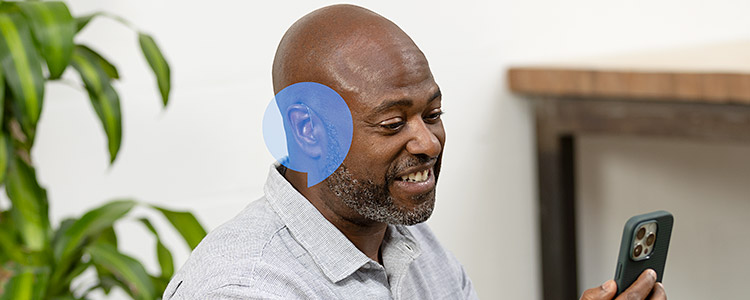“Cookie-bite” hearing loss means someone has difficulty hearing the middle frequencies of sound.
For people with cookie-bite hearing loss, their audiogram (the graph that shows how well you can hear) dips in the middle. This dip resembles a cookie with a bite taken out of it, hence the name.

Cookie-bite hearing loss is a type of sensorineural hearing loss which means it is caused by damage to the inner ear or auditory nerve.
Much of human speech and music takes place in the middle-frequency sound range, which is why this type of hearing loss can have a huge impact on your quality of life.
The effect of cookie-bite hearing loss on understanding speech
Low-frequency hearing loss takes away the bass sounds like 'b,' 'm,' and 'u’, making it difficult to pick up on the rhythm of speech.
Mid-frequency hearing loss affects words with 'r,' 'ch,' and 'g,' making everyday conversations difficult to follow.
High-frequency hearing loss impacts 's,' 'f,' and 'th' – leaving gaps in the clarity of speech.
What causes cookie bite hearing loss?
Cookie-bite hearing loss is thought to be a genetic condition, but it doesn’t necessarily start at birth – it can appear later in life. For some people, cookie-bite hearing loss gets worse over time while for others it stays more or less the same.

Common signs of mid-frequency hearing loss
With mid-frequency hearing loss, you might be able to hear birdsong or thunder rumbling without any problems, but may find that other people seem to be mumbling most of the time. That’s because the first two sounds are high- and low-pitched (respectively), whereas speech falls into the mid-frequency range.
You may struggle to hear your favourite music or turn the TV up very loudly to hear the dialogue. Social situations and even work environments might be difficult to navigate due to background noise. You might often find yourself asking people to repeat themselves; sounds seem unclear, or people sound like they are mumbling.
What do the experts say?
Our Head of Audiology, Laura Ewen, says, “Mid-frequency hearing loss isn’t as common as other types of loss that come on through age or through noise. One of the most prevalent symptoms of mid-frequency – or “cookie-bite” – hearing loss, is difficulty hearing speech. So if you struggle with everyday conversations, especially when there’s background noise, or if you’re not looking directly at the speaker, it’s definitely worth getting your hearing checked as it could dramatically improve your quality of life.”

Above: Laura Ewen, Head of Audiology
Cookie-bite hearing loss: Sandra’s story
One of our customers, Sandra Pierce, first started to notice her hearing loss in her late 30s.

“I went to retrain with the hope of being a teacher and did a course at the local college,” she says. “It was there I realised straight away that I could not hear what the tutor was saying when he turned towards the blackboard or when any of the students spoke with their backs to me. All I could make out was muffled voices from the students. My anxiety levels went through the roof.”
Sandra was suffering from cookie-bite hearing loss, but after being fitted with state-of-the-art hearing aids by Hidden Hearing, her quality of life has improved drastically.
“I no longer live in fear of the phone ringing! Since getting my hearing aids, my confidence has soared.” You can read Sandra’s full story here.
Treatment options for cookie-bite hearing loss
Mid-frequency hearing loss is relatively uncommon, but that doesn’t mean it can’t be treated.
Today’s hearing aid technology is highly personalised, and can be customised to treat a cookie-bite hearing loss pattern.
Treating cookie-bite loss with hearing aids could help you stay connected with family and friends.

If you’re having difficulty understanding speech, either in conversations or listening to dialogue on the TV or radio, we’re here to help. You can book a free hearing test with one of our experts. Just follow the link to book.




